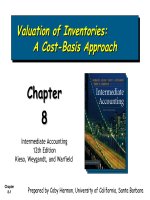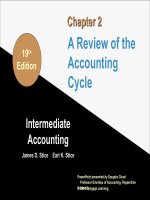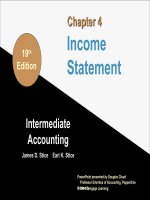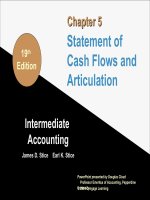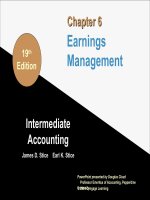Intermediate accounting 19th by stice stice chapter 08
Bạn đang xem bản rút gọn của tài liệu. Xem và tải ngay bản đầy đủ của tài liệu tại đây (177.93 KB, 57 trang )
Chapter 8
19th
Edition
Revenue
Recognition
Intermediate
Accounting
James D. Stice
Earl K. Stice
PowerPoint presented by Douglas Cloud
Professor Emeritus of Accounting, Pepperdine
University
© 2014 Cengage Learning
8-1
Revenue Recognition
Recognition refers to the time when
transactions are recorded on the books. The
FASB’s two criteria for recognizing revenues
and gains are when:
1. They are realized or realizable.
2. They have been earned through substantial
completion of the activities involved in the
earnings process.
Both
Bothof
ofthese
thesecriteria
criteriagenerally
generallyare
are
met
metat
at the
the point
point of
ofsale
sale
8-2
Revenue Recognition
• Revenue is not recognized prior to the point of sale
•
because either:
A valid promise of payment has not been
received from the customer.
The company has not provided the product or
service.
Exceptions to these rules:
The customer provides a valid promise of
payment.
Conditions exist that contractually guarantee the
sale.
(continued)
8-3
Revenue Recognition
AICPA Statement of Position 97-2 gives
companies more guidance through a checklist of
four factors that amplify the two criteria:
1) Persuasive evidence of an arrangement
exists.
2) Delivery has occurred.
3) The vendor’s fee is fixed or determinable.
4) Collectibility is probable.
(continued)
8-4
Revenue Recognition
•
The FASB is currently engaged in a
revenue recognition project in conjunction
with the IASB (as of June 2010).
•
The FASB has tentatively decided to move
away from the realization and substantial
completion criteria and to instead
emphasize the measurement of a seller’s
satisfaction of performance obligations
created through contracts with customers.
8-5
SAB 101
•
Because SAB 101 was released to curtail
specific abuses, it should not be seen as a
comprehensive treatise on the entire area
of revenue recognition.
•
Revenue recognition issues covered in
SAB 101 may not be comprehensive, but
they are extremely important.
8-6
Sarbanes-Oxley Act of 2002
•
Section 404 of the Sabanes-Oxley Act of
2002 instructs the SEC to require all publicly
traded companies to provide a report of the
condition of the company’s internal controls.
•
This is to ensure that the public financial
statements are not rendered irrelevant by
secret side agreements.
•
A good internal control system establishes
procedures to safeguard the value of a
company’s assets.
8-7
Accounting for Consignments
Seller Company ships goods costing $1,000
on consignment to Consignee Company.
The retail price of the goods is $1,500.
No
No sale
sale should
should be
be recorded.
recorded.
However,
However, there
there may
may be
be aa journal
journal entry
entry
made
made to
to reclassify
reclassify the
the inventory.
inventory.
Inventory on Consignment
Inventory
1,000
1,000
8-8
Accounting for a Layaway Sale
Seller Company receives $100 cash from a
customer. The $100 payment is a partial
payment for goods costing $1,000 with a total
retail price of $1,500. The following entry shows
the receipt of $100 cash as initial layaway
payment.
Cash
Deposit Received from Customers
100
100
(continued)
8-9
Accounting for a Layaway Sale
Recording the receipt of the final $1,400 cash
payment and the delivery of goods to
customers requires two entries. One to record
the sale and the second to remove the item
from inventory and to record its cost.
Cash
Deposit Received from Customer
Sales
1,400
100
Cost of Goods Sold
Inventory
1,000
1,500
1,000
8-10
Bill-and-Hold Arrangements
To consider merchandise as sold using the
bill-and-hold arrangement, a seller must be
able to demonstrate:
• that the goods are ready to ship,
•
that they are segregated in act and cannot
be used to fill other orders, and
•
that the buyer has requested, in writing, the
bill-and-hold arrangement.
8-11
Customer Acceptance Provisions
Seller Company receives $1,500 cash from a
customer as payment in full for equipment
costing $1,000. The sale is not complete until
the equipment is installed at the customer’s
place of business. The following entry is
necessary to record the advance receipt of
money:
Cash
Advance Payments Received
from Customers
1,500
1,500
(continued)
8-12
Customer Acceptance Provisions
Two entries are required to record customer
acceptance of the installed equipment.
Advance Payments Received from
Customers
Sales
Cost of Goods Sold
Inventory
1,500
1,500
1,000
1,000
8-13
Appropriate Accounting for a Service
Provided Over an Extended Period
Seller Company receives $1,000 cash from a
customer as the initial sign-up fee for a
service. In addition to the sign-up fee, the
customer is required to pay $50 per month for
the service. The expected economic life of this
service agreement is 100 months. An entry is
required to show receipt of cash.
Cash
Unearned Initial Sign-up Fees
1,000
1,000
(continued)
8-14
Appropriate Accounting for a Service
Provided Over an Extended Period
A second entry is required to record receipt of
the monthly payment.
Cash
Monthly Service Revenue
50
50
Another entry is necessary to record partial
recognition of the initial sign-up fee as revenue
($1,000/100 months).
Unearned Initial Sign-up Fees
Initial Sign-up Fee Revenue
10
10
8-15
Subtopic 605-25
•
The focus of Subtopic 605-25 is on the
“unit of accounting.”
•
An element of multiple-element
arrangement is considered to be a unit
of accounting if that element has
standalone value.
•
An element has standalone value if it is
sold separately or if the customer
resells it.
8-16
Income Statement Presentation of
Revenue: Gross or Net
Characteristic of a transaction in which a
company should report revenue on a net basis
are given as follows:
• The company does not maintain an inventory
of the product being sold but simply forwards
orders to a supplier.
•
The company is not primarily responsible for
satisfying customer requirements, request,
complaints, and so forth; those requirements
are satisfied by the supplier of goods.
(continued)
8-17
Income Statement Presentation of
Revenue: Gross or Net
•
The company earns a fixed amount, or a fixed
percentage, and doesn’t bear the risk of
fluctuations in the margin between the selling
price and the cost of goods sold.
•
The company does not bear the credit risk
associated with collecting from the customer;
that risk is borne by the supplier.
8-18
A Contract Approach to
Revenue Recognition
The contract approach contains three basic
steps:
1) Identify the performance obligations accepted
by a seller in its contracts with its buyers.
2) For multiple-element transactions, allocate
transaction prices based on relative separate
selling prices.
3) Recognize revenue when performance
obligations are satisfied.
(continued)
8-19
A Contract Approach to
Revenue Recognition
• With the contractual performance obligation
focus, the FASB and IASB have agreed
that revenue arises when a seller satisfies a
performance obligation to a buyer.
• The general idea that no revenue should be
recognized until something of value has
been delivered to the customer goes back
to SAB 101 and even back to the traditional
revenue recognition criteria.
(continued)
8-20
A Contract Approach to
Revenue Recognition
Ashley Company has provided goods, on
account, to customers during the month of June
with a total billing price of $100,000. Bad debts
are expected to be 1.0% of the gross sales
amount, and sales returns are expected to be
2.5% of the gross sales amount. A summary
journal entry follows:
June 30
Accounts Receivable
Sales Revenue [$100,000 x
(100.0% ‒ 1.0% ‒ 2.5%)]
(continued)
96,500
96,500
8-21
A Contract Approach to
Revenue Recognition
Wilks Company sells a plasma TV and 2-year
warranty to a customer for the joint price of
$2,000. Wilks Company has generated the
following information regarding the sale of the
plasma TV.
• Cost of plasma TV, $1,500
•
Sales price of plasma TV sold separately is
unknown. Other consumer electronic products
have profit margins that range between 16%
and 22% of cost.
(continued)
8-22
A Contract Approach to
Revenue Recognition
•
Sales price of warranty if sold separately,
unknown. A 2-year warranty for a
refrigerator/freezer with the same wholesale
cost sells for $300. Wilks estimates that repair
costs for the plasma TV would be 5% higher
($300 + ($300 x .05) = $315).
TV delivery obligation: $1,700 = $2,000 x
[$1,785/($1,785 + $315)]
Warranty service obligation: $300 = $2,000 x
[$315/$1,785 + $315)]
(continued)
8-23
A Contract Approach to
Revenue Recognition
The journal entry to record the asset and liability
at the contract signing is as follows:
Cash
Contract Liability—TV
Contract Liability—Warranty
2,000
1,700
300
When the plasma TV is delivered, the following
journal entries are required:
Contract Liability—TV
Sales Revenue
Cost of Goods Sold
Inventory
1,700
1,700
1,500
1,500
8-24
Introduction
•
If a Company waits until the production or
service period is complete to recognize
revenue, this approach is referred to as the
completed-contract method. All income
from the contract is related to the year of
completion.
•
Percentage-of-completion accounting was
developed to relate recognition of revenue on
long-term construction-type contracts to the
activities of a firm in fulfilling these contracts.
8-25
